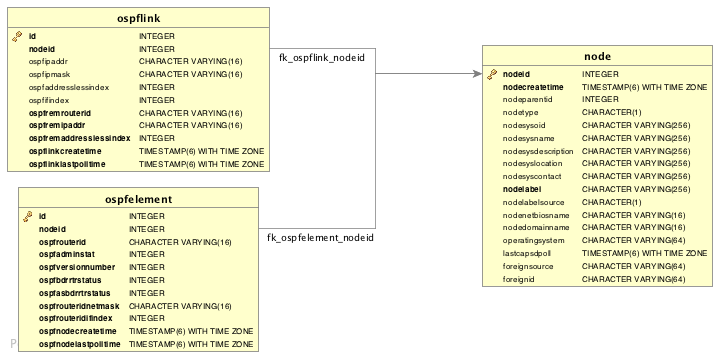OSPF Discovery
OSPF links are found in the ospfNbrTable (defined in the OSPF-MIB module) and persisted in the ospfLink table.
The relevant MIBs for creating an OSPF topology are those in the OSPF-MIB and OSPF-TRAP-MIB modules. They define the relevant objects used to find OSPF links—specifically, the router ID.
In OSPF, the router ID has the same format as an IP address, but identifies the router independently of its IP address. All interfaces are identified by their IP addresses.
You can find generic information about the OSPF link discovery process in the OSPF Information box on any device’s Node Detail page.
OSPF Topology Updater
The OSPF Topology Updater consolidates OSPF data and provides the OSPF OnmsTopology. Only full bidirectional connections between two OSPF-supported devices become edges in the topology. For example, node A and node B are connected by an edge if, and only if, there is an OSPF link in Node A to Node B, and vice versa.
Information gathered from supported OIDs is stored in the following database tables:

Supported OIDs
| Name | Description | OID |
|---|---|---|
ospfRouterId |
32-bit integer uniquely identifying the router in the autonomous system.
By convention, to ensure uniqueness, this should default to the value of one of the router’s IP interface addresses. |
.1.3.6.1.2.1.14.1.1.0 |
ospfAdminStat |
Administrative status of OSPF in the router.
The value |
.1.3.6.1.2.1.14.1.2.0 |
ospfVersionNumber |
Current version number of the OSPF protocol ( |
.1.3.6.1.2.1.14.1.3.0 |
ospfAreaBdrRtrStatus |
Flag that notes whether this router is an area border router. |
.1.3.6.1.2.1.14.1.4.0 |
ospfAreaASBdrRtrStatus |
Flag that notes whether this router is configured as an autonomous system border router. |
.1.3.6.1.2.1.14.1.5.0 |
ospfAreaId |
A 32-bit integer uniquely identifying an area.
Area ID |
.1.3.6.1.2.1.14.2.1.1 |
ospfAuthType |
The authentication type specified for an area. |
.1.3.6.1.2.1.14.2.1.2 |
ospfImportAsExtern |
Indicates if an area is a stub area, NSSA, or standard area. Type-5 AS-external LSAs and type-11 Opaque LSAs are not imported into stub areas or NSSAs. NSSAs import AS-external data as type-7 LSAs. |
.1.3.6.1.2.1.14.2.1.3 |
ospfAreaBdrRtrCount |
The total number of area border routers reachable within this area. This value is initially zero and is calculated in each Shortest Path First (SPF) pass. |
.1.3.6.1.2.1.14.2.1.5 |
ospfAsBdrRtrCount |
The total number of autonomous system border routers reachable within this area. This value is initially zero and is calculated in each SPF pass. |
.1.3.6.1.2.1.14.2.1.6 |
ospfAreaLsaCount |
The total number of link state advertisements in this area’s link state database, excluding AS-external LSAs. |
.1.3.6.1.2.1.14.2.1.7 |
ospfIfIpAddress |
IP address of this OSPF interface. |
.1.3.6.1.2.1.14.7.1.1 |
ospfAddressLessIf |
Takes the value |
.1.3.6.1.2.1.14.7.1.2 |
ospfNbrIpAddr |
IP address this neighbor uses in its IP source address.
Note that on addressless links, this will not be |
.1.3.6.1.2.1.14.10.1.1 |
ospfNbrAddressLessIndex |
Takes the value |
.1.3.6.1.2.1.14.10.1.2 |
ospfNbrRtrId |
32-bit integer (represented as an |
.1.3.6.1.2.1.14.10.1.3 |
| Name | Description | OID |
|---|---|---|
ipAdEntIfIndex |
Index value that uniquely identifies the interface to which this entry applies.
The interface identified by a particular value of this index is the same interface as identified by the same value of |
.1.3.6.1.2.1.4.20.1.2 |
ipAdEntNetMask |
Subnet mask associated with the IPv4 address of this entry.
The value of the mask is an IPv4 address with all the network bits set to |
.1.3.6.1.2.1.4.20.1.3 |